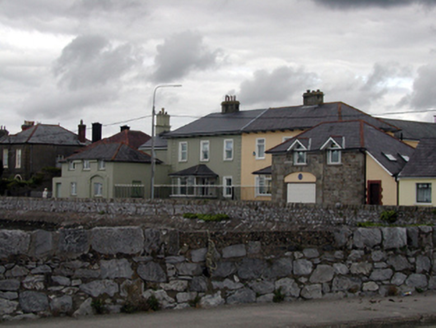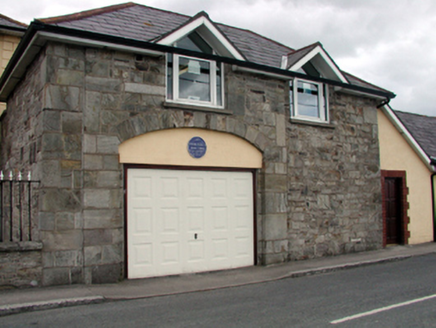Survey Data
Reg No
22821008
Rating
Regional
Categories of Special Interest
Architectural, Historical, Social
Original Use
RIC barracks
In Use As
House
Date
1830 - 1850
Coordinates
226520, 93196
Date Recorded
20/08/2003
Date Updated
--/--/--
Description
Semi-detached three-bay two-storey house, c.1840, originally part of larger detached six-bay two-storey police station with building to north-west with three-bay two-storey lower return to north-east. Extensively renovated, c.1965, with single-bay single-storey projecting glazed porch added to centre. Hipped (shared) slate roof (pitched to return) with clay ridge tiles, cut-stone chimney stack on axis with ridge, and cast-iron rainwater goods on overhanging eaves having consoles. Hipped artificial slate roof to porch with clay ridge tiles, and plastic rainwater goods on timber eaves. Painted rendered walls with rendered quoined pier to end. Square-headed window openings with rendered sills, moulded rendered surrounds, and replacement timber casement windows, c.1965. Square-headed openings to porch with concrete sill, timber casement windows, and replacement glazed uPVC panelled door, c.1990, having overlight. Set back from line of road with sections of cast-iron railings to forecourt on random rubble stone plinth having finials, and cast-iron gate. (ii) Detached two-bay single-storey rubble stone coach house with half-attic, c.1840, to south with segmental-headed carriageway to left ground floor, and single-bay single-storey linking bay to north. Extensively renovated, c.1990, with attic remodelled. Hipped roof (gabled to attic windows) with replacement slate, c.1990, clay ridge tiles, and replacement uPVC rainwater goods, c.1990, on timber eaves. Random rubble stone walls repointed, c.1990, with cement ribbon pointing having irregular coursed squared rubble stone section to carriageway, and cut-stone coping to parapet to linking bay. Triangular-headed window openings remodelled, c.1990, with replacement concrete sills, c.1990, and replacement uPVC casement windows, c.1990. Segmental-headed carriageway remodelled, c.1990, with replacement uPVC panelled door, c.1990, having rendered overpanel with cast-iron plaque. Square-headed door opening to linking bay with cut-granite block-and-start surround, and replacement tongue-and-groove timber panelled door, c.1990.
Appraisal
A well-proportioned house, originally built as part of a larger composition (with 22821009/WD-31-21-09), which is of particular significance for its original intended use as a police station. Subsequently converted to residential use, the house is of additional significance in the locality for its historic associations with Sarah Purser (1848 – 1943), artist. Although much of the original fabric has been replaced, leading to the loss of some of the historic patina, the house retains most of its original form and massing. The survival of the original coach house, although altered, enhances the visual appeal of the site, while the survival of the original cast-iron railings to the forecourt augments the visual appeal of the street scene.





